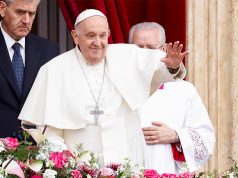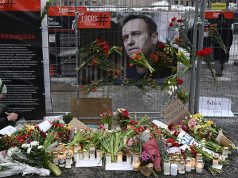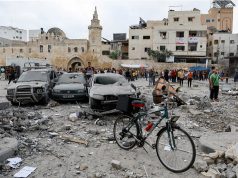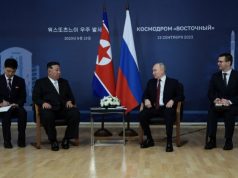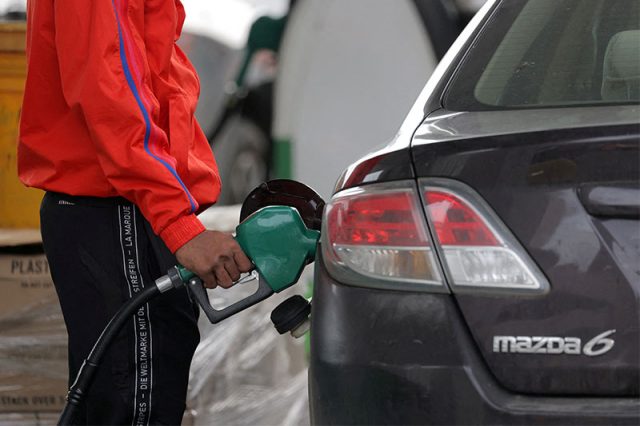
Comparisons of real-life gas prices to the fictional ones seen in the post-apocalyptic movie “I Am Legend” surfaced amid the price hike in the global market as a result of Russia’s invasion of Ukraine.
Tina Patel, a news reporter of CBS Los Angeles and KCAL-TV, shared a picture of gas prices seen in a refilling station in Los Angeles on March 3 with the caption, “Yikes.”
Yikes 😳
(Beverly & La Cienega, Los Angeles) pic.twitter.com/Du7hwseXfv— Tina Patel (@tina_patel) March 3, 2022
The next day, she uploaded another picture of the station’s gas prices with the caption, “UPDATE—it went up again!”
UPDATE— it went up again! pic.twitter.com/UncqfjyzRU
— Tina Patel (@tina_patel) March 3, 2022
Patel’s second picture was reposted by Ryan Fish, a reporter of KGUN 9.
He compared it to the gas prices spotted in “I Am Legend,” a 2007 sci-fi-thriller movie based on the 1954 novel of the same name. The movie’s setting is in New York City in 2012.
“LA has reached ‘I Am Legend’ gas prices,” Fish tweeted with a screengrab of gas prices seen in the background.
LA has reached 'I Am Legend' gas prices
(via @tina_patel) pic.twitter.com/8lTKkQh8xV
— Ryan Fish (@RyanFishTV) March 5, 2022
Another Twitter user also spotted a similar scene and quipped that he would have “started (eating) people too” with those kinds of gas prices.
His comment is a reference to the zombie-like characters in the movie.
So I’m watchin I AM LEGEND…and I finally kno why the world ended 🧠 LOOK AT THEM MFIN GAS PRICES 🗣🤯🤬 I woulda started eatin people too shiddd Tf 🅿️😂🤦🏾♂️‼️ pic.twitter.com/mcLC6HofwB
— ThatGuyPc 💯🤦🏾♂️ (@_EastsidePc) April 16, 2020
It was not only Fish who used the “I Am Legend” gas prices for comparison.
Twitter user Taylor Trandahl also shared another picture of a different gas refilling station with the caption, “Gas is now officially more expensive than the movie ‘I Am Legend’ imagined it would be during the apocalypse.”
She juxtaposed the picture with that of the gas prices in the movie at a different angle.
Gas is now officially more expensive than the movie I Am Legend imagined it would be during the apocalypse. pic.twitter.com/Av98Vdiwxn
— Taylor Trandahl (@ttrandahl) March 7, 2022
Her tweet became viral and users compared it to their situation in real-life in which gas prices are also soaring.
“Hardly confined to the US though! It’s over £1.60 per litre in the UK,” a Twitter user claimed in the thread, referring to the United Kingdom.
“Ha, these are the Dutch ‘normal old’ prices. In dollars (and) gallons, now in the NL the #benzineprijs is reaching ~$10.00 (€2.43 per litre)…” another online user claimed, referring to The Netherlands.
What’s happening now
Gas prices in the United States have been initially soaring due to domestic and global inflation. It was made worse by the ongoing Russia-Ukraine crisis.
“What we’re observing is essentially an energy price shock and a financial markets shock that comes on the back of this already concerning inflation environment, an environment in which global supply chains are already stressed and in which there is already some degree of uncertainty as to the outlook,” EY-Parthenon chief economist Gregory Daco said in a Vox report.
The Philippines just experienced a hefty hike in its petroleum products on Tuesday. Companies have increased the gasoline prices by P3.60 per liter and P5.85 per liter on diesel. Others similarly increased their kerosene prices by P4.10 per liter. Local oil prices have been going up in the country for the past 10 weeks.
Russia, which launched its assaults in February before its troops invaded Ukraine, is also one of the world’s biggest oil and gas producers.
The report cited that in early February, JPMorgan analysts projected that disruptions to oil flows from Russia could push oil prices to $120 per barrel. It has already happened.
The situation is similar in Europe.
The Guardian on March 4 reported that both British and European gas prices have increased amid the Ukraine invasion. It is “the country through which many of its gas pipelines to Europe run.”
“The market is trying to price both the likelihood and impact of a Russian flow cut, be it due to the conflict in Ukraine causing physical disruption to gas transit or due to a ramp-up in sanctions cutting flows all together,” ICIS European gas analyst Tom Rodgers was quoted.
Vox explains that the current crisis between the two countries has grown from the breakup of the Soviet Union, a federal state in which Ukraine was one of its republics. At that time, the latter had the third-largest atomic arsenal in the world.
The report notes that Russian President Vladimir Putin “has been fixated on reclaiming some semblance of empire, lost with the fall of the Soviet Union.”




